Rough Terrain Cranes and Telehandlers
// June 19, 2025
Rough terrain (R/T) cranes and telehandlers are the workhorses of off-road construction designed to tackle challenging environments where traditional equipment might falter.
These machines are built to handle the toughest jobs, from steep slopes to unstable ground. However, their effectiveness hinges on proper setup, operation, and maintenance, and their performance depends on the operator’s commitment to safety.
Albert Wang’s article Navigating the Terrain in Crane & Hoist Canada’s current May/June Magazine details the many considerations operators will need to manage to use rough terrain cranes and telehandlers safely and effectively in a vastly varied conditions on-the-job.
Here’s a quick summary of some of the main points to consider:
Access and Egress: The Step to Safety
The risk of a slip, trip or falls is high on when working in environments of uneven terrain, mud, and debris. For R/T cranes and telehandlers, operators must ensure that steps, handrails, and platforms are free of obstructions and slip hazards. Always maintain three points of contact when climbing in or out of the equipment.
Setup: Stability is Key
Operating on uneven ground or steep slopes is one of the most challenging aspects of equipment operation in construction. Before positioning equipment, conduct a thorough hazard assessment along all points of your travel and different work areas.
Ground Conditions: The Foundation of Safe Operations
Understanding and evaluating ground conditions are critical for the safe operation of R/T cranes and telehandlers. Operators should perform site assessment, as part of the hazard assessment mentioned in the previous section, to identify potential hazards such as soft soils, uneven terrain, or underground voids that could compromise the equipment’s stability. Weather variables, such as winter conditions with frost and ice, can further complicate operations.
Leveling the Crane: A Critical Step
Proper levelling is crucial for preventing tip-overs during crane operations. Mobile cranes and boom trucks use outriggers or other stabilizing equipment for levelling. Outriggers should be fully extended beams and placed onto the pads on stable, level ground. If the terrain is uneven, use cribbing or mats to create a stable foundation.
Telehandlers should be equipped with appropriate tires for the terrain—pneumatic tires for softer ground and solid tires for rocky or abrasive surfaces.
Preventive Maintenance: The Unsung Hero
While this article focuses on operational considerations, it’s impossible to overlook the importance of preventive maintenance. R/T cranes and telehandlers are subjected to harsh conditions, and regular maintenance is crucial to keep them running safely and efficiently.
Regulatory Compliance: The Framework for Safe Operations
Follow the local regulatory requirements for safety devices on the R/T cranes and telehandlers. In B.C., the OHSR mandates a minimum of three-point seat belts in some high-risk environments, particularly for certain types of Rollover Protective Structure (ROPS) equipped prime movers to reduce upper-body trauma risks during rollovers.
Read the full article in Crane & Hoist Canada’s May/June 2025 magazine.




